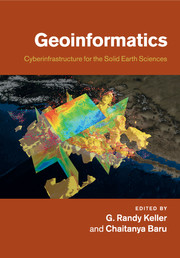Book contents
- Frontmatter
- Contents
- List of contributors
- Preface
- Introduction
- 1 Science needs and challenges for geoinformatics
- 2 Introduction to IT concepts and challenges
- Part I Case studies from other disciplines
- Part II Modeling software and community codes
- Part III Visualization and data representation
- Part IV Knowledge management and data integration
- Part V Web services and scientific workflows
- Part VI Emerging international and other efforts
- Index
- Plate section
- References
2 - Introduction to IT concepts and challenges
from Introduction
Published online by Cambridge University Press: 25 October 2011
- Frontmatter
- Contents
- List of contributors
- Preface
- Introduction
- 1 Science needs and challenges for geoinformatics
- 2 Introduction to IT concepts and challenges
- Part I Case studies from other disciplines
- Part II Modeling software and community codes
- Part III Visualization and data representation
- Part IV Knowledge management and data integration
- Part V Web services and scientific workflows
- Part VI Emerging international and other efforts
- Index
- Plate section
- References
Summary
Scientific applications have been at the forefront of driving computer and information technology since the early days: from the development of early computers for numerical computing, to the introduction in the USA of the NSFNET (which helped launch the Internet), and the subsequent invention of the World Wide Web. The geosciences, in particular, have been a long-standing user of such technologies, given the importance of applications related to weather, natural resources, natural hazards, and environmental monitoring. Scientific computing was focused initially on the need for fast computers to perform larger numbers of complex numerical calculations. The concerns more recently have turned towards the ability to manage the very large amounts of data that are being generated by a wide range of sensors and instruments, sophisticated observing systems, and large-scale simulations on large computer systems. Data rates of terabytes per day and petabytes per year are not uncommon (1 petabyte = terabytes) (Hey et al., 2009, p. 9). Yet, computer science and information technology solutions must deal not only with the size and scale of data, but also the inherent richness and complexity of scientific data – especially when data are combined across multiple projects, institutions, and even multiple science disciplines and subdisciplines. The need to understand complex, interdependent, natural as well as anthropogenic phenomena has made science a team sport, requiring collaborations among multidisciplinary teams of scientists to process, analyze, and integrate extremely heterogeneous data.
- Type
- Chapter
- Information
- GeoinformaticsCyberinfrastructure for the Solid Earth Sciences, pp. 10 - 18Publisher: Cambridge University PressPrint publication year: 2011

